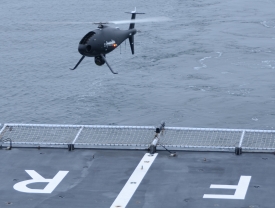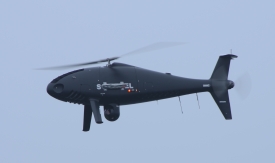 At the request of the Dutch Coast Guard, Austrian company Schiebel recently gave a demonstration of its Schiebel Camcopter® S-100 unmanned helicopter from the helideck of the Dutch patrol vessel Zr. Ms. Friesland. Three scenarios were used to show ways of deploying unmanned helicopters for SAR, maritime assistance and enforcement. The demonstration was attended by representatives of organisations involved in maritime security. Besides the Coast Guard these included Schiebel, the Royal Netherlands Navy, the Royal Netherlands Military Constabulary, Customs, Police, the Public Prosecution Service, the Directorate-General for Mobility and the Netherlands Food and Consumer Product Safety Authority as well as regulatory parties such as the Human Environment and Transport Inspectorate, the Military Aviation Authority, the Radiocommunications Agency and the National Aerospace Laboratory (NLR) of the Netherlands. Others in attendance were Damen Shipyards, Thales, TNO and the State Harbourmasters of Amsterdam, Rotterdam and Den Helder.
At the request of the Dutch Coast Guard, Austrian company Schiebel recently gave a demonstration of its Schiebel Camcopter® S-100 unmanned helicopter from the helideck of the Dutch patrol vessel Zr. Ms. Friesland. Three scenarios were used to show ways of deploying unmanned helicopters for SAR, maritime assistance and enforcement. The demonstration was attended by representatives of organisations involved in maritime security. Besides the Coast Guard these included Schiebel, the Royal Netherlands Navy, the Royal Netherlands Military Constabulary, Customs, Police, the Public Prosecution Service, the Directorate-General for Mobility and the Netherlands Food and Consumer Product Safety Authority as well as regulatory parties such as the Human Environment and Transport Inspectorate, the Military Aviation Authority, the Radiocommunications Agency and the National Aerospace Laboratory (NLR) of the Netherlands. Others in attendance were Damen Shipyards, Thales, TNO and the State Harbourmasters of Amsterdam, Rotterdam and Den Helder.
Unmanned aircraft are subject to the same ‘standard’ rules that apply to manned aviation except where exceptions are made specifically for unmanned aircraft (lightweight or otherwise). Professional flights with unmanned light aircraft may be made in the Netherlands only if the flight operating organisation holds a ‘combi exemption’ granted by the Human Environment and Transport Inspectorate.
In the lead-up to the demonstration NLR supported Schiebel and the Coast Guard in obtaining the required exemptions. These included a combi exemption for flying an unmanned aircraft and an exemption granting permission to use certain frequencies and transmitting powers for the data link.
 NLR possesses considerable expertise of the laws and regulations in this field and also maintains close contacts with civil and military aviation authorities. This enabled NLR to provide effective support to Schiebel in getting the necessary exemptions. An air space sector was closed to other air traffic during the Camcopter® S-100 demonstration. To make better use of the possibilities of unmanned aircraft it would be beneficial also to be able to operate in open air space. This matter is being comprehensively examined in a two-year project called AIRICA (‘ATM Innovative RPAS Integration for Coastguard Applications’) that is being funded partly by the European SESAR (Single European Sky ATM (Air Traffic Management) Research) Joint Undertaking. The project includes equipping an unmanned aircraft with a ‘Detect and Avoid’ system to allow the aircraft independently to detect other air traffic and, if necessary, to take action to avoid a collision. The project will end with a demonstration in which an unmanned aircraft will operate safely in air space that has not been closed off. For more information visit the website www.airica.eu.
NLR possesses considerable expertise of the laws and regulations in this field and also maintains close contacts with civil and military aviation authorities. This enabled NLR to provide effective support to Schiebel in getting the necessary exemptions. An air space sector was closed to other air traffic during the Camcopter® S-100 demonstration. To make better use of the possibilities of unmanned aircraft it would be beneficial also to be able to operate in open air space. This matter is being comprehensively examined in a two-year project called AIRICA (‘ATM Innovative RPAS Integration for Coastguard Applications’) that is being funded partly by the European SESAR (Single European Sky ATM (Air Traffic Management) Research) Joint Undertaking. The project includes equipping an unmanned aircraft with a ‘Detect and Avoid’ system to allow the aircraft independently to detect other air traffic and, if necessary, to take action to avoid a collision. The project will end with a demonstration in which an unmanned aircraft will operate safely in air space that has not been closed off. For more information visit the website www.airica.eu.
Also visit our Remotely Piloted Aircraft (RPAS) Regulations capability page or Netherlands RPAS Test Centre.


